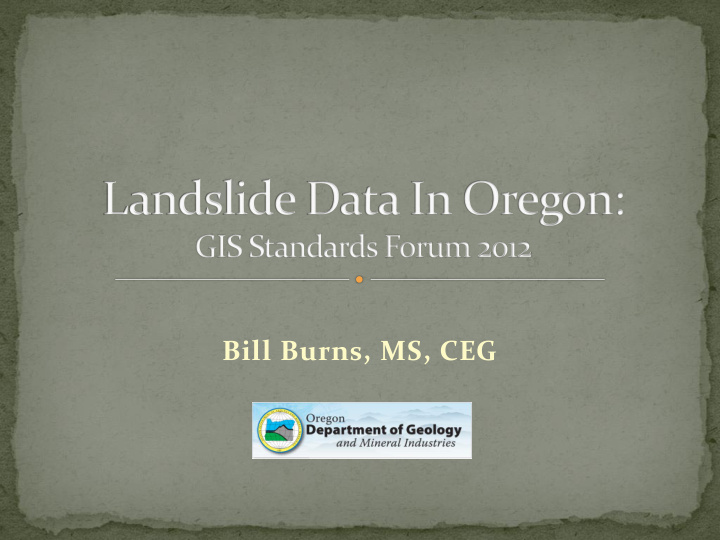



Bill Burns, MS, CEG
Hazards Elements Floods Landslide Earthquake Wildfire Tsunami Volcano Natural Hazardous Materials Geologic Floodplain Coastal Erosion Climate
Oregon Department of Geology and Mineral Industries (DOGAMI) Oregon Department of Transportation (ODOT) Washington County, Oregon City of Astoria, Oregon U.S. Geological Survey Landslide Program (USGS)
I. Landslides 101 II. SLIDO r1 and r2(2011) III. Future Updates to SLIDO
Landslides 1996-1997 3 Storms, 100s Millions $ Damage, 5 deaths, 9,500 slides!
Soil (earth) Classification or Naming Landslides Rock Primary Criteria: Debris (mixture) 1) Type of Material I. Slides 2) Type of Movement II. Flows III. Spreads IV. Falls V. Topples Complexes (multiple types) Debris Flow, Rock Fall
Slides Soil or rock sliding on a surface of rupture (failure plane). Commonly where weak soil overlies stronger soil or rock. Landslide in Forest Park Rotational Slides (Slumps) Translational Slide The Zoo Landslide (ancient Highlands Landslide) USGS, Fact Sheet 2007-3072, 2004
Flows mixtures of water and/or soil-rock-debris which have become a liquefied slurry and move commonly very rapidly down slope. Non-channelized Flows (Earth Flows) Earth Flow in the Portland Hills Channelized Flows (Debris flows or Rapidly Moving Landslides) Debris Flow, Columbia River Gorge, Dodson Debris Flow, HWY 30, Woodson USGS, Fact Sheet 2007-3072, 2004 Ken Cruikshank, http://www.geol.pdx.edu/ PSU-METRO, 1998
Falls are near vertical movements of masses of geologic Falls & materials, such as rocks and/or boulders. They usually occur very rapid. Topples Toppling failures are distinguished by the forward rotation of the mass about some pivot point Falls Rock Fall, HWY 99E, Oregon City Rock Fall, SW Burnside Topples And Tichner, Portland Rock Topple, I-84 Near Multnomah Falls PSU-METRO, 1998 USGS, Fact Sheet 2007-3072, 2004 PSU-METRO, 1998Burns, 2006
Slow (inches per year) Deep-Seated Shallow-Seated Fast (50mph) and Travel Far (miles)
SLIDO Release 1, 2008 1. Compilation of previously mapped landslide polygons Mostly scan old paper maps and digitize 257 studies, 15,000 landslides, single shapefile SLIDO Release 2, 2011 2. More polygons, mainly from lidar 1. mapping New historic points database 2. New detailed studies locations database 3. New reference details 4.
1. SLIDO r1 2. Historic Points 3. Mapped Polygons 1. Deposits 2. Scarp_Flanks 3. Scarps 4. Detailed Studies (individual slides) 5. Reference Map and Table
Current Data in SLIDO R2 & Future Updates
Centroid points of historic (~1849+) landslides Data was compiled from several datasets (primarily 96-97 database and ODOT) Each point includes 25 fields (data source, location method, date, size, damage, etc.)
ODOT data Keep adding as they get put into GIS Add future landslides Future storms Example: January 2012 storm – 40 slide Orthophotos Example: 2007 storm 1995, 2000, 2005, 2009, 2011 Aerial Photos Example: Mt. Hood (points and sometimes polygons) 1930s to present
• 2007 December Storm • Multiple studies document 1,000s of landslides SW Washington • No regional studies in Oregon 2005-2009 NAIP 1,400 landslides Method Paper Coming Soon !
2005 NAIP
2009 NAIP
Mapped Historic Landslide Points First Return Bare Earth
Current Data in SLIDO R2 & Future Updates
Mostly compilation of mapped landslide deposits (polygons) Results in polygons on top of polygons due to authors interpretation Do not know which author is correct, therefore we included all polygons to be conservative Lidar-based mapping areas we stamp out ALL existing data and replaced with new This is primary process for future updates. Each polygon includes 31 fields (2,100 out of 22,000 <10%)
Lidar +Basemap Can See the Landslides !
SLIDO r2 Polygons on top of polygons ! Generalized location of all the landslide features.
SLIDO r2
Lidar-based Polygons Main Deposit (red) Head Scarp & Flanks (orange) Internal Scarps (brown) Publish as: Interpretive Map Series (IMS)
Lidar-Based Polygons Plus SLIDO r2 Some come and some go !
Activity Historic or Prehistoric Depth of Failure Shallow or Deep Certainty of Identification Low, mod, high Type of Landslide Slide, flow, fall, topple, spread Slope, geology, direction… 30 attributes in the GIS files
Geodatabase from Oregon Spatial Data Library View Interactive Web Map (DOGAMI) Publications from DOGAMI
Example: Neighborhood in East Astoria Small amount of grading caused big problem
City or county regulation tied to new maps Building permit or proposed grading permit conditions Must assure site will be more stable during and after construction Could have been avoided?
Landslide hazards are unique Example: Earthquake & Flood hazards Have been studied in detail for centuries Much better understanding of the hazard Resulted in availability of insurance Also, lots of help from the Federal Government (FEMA, USGS, NOAA, NEHRP, etc) pre & post disasters Majority of events, all is lost.
Recommend
More recommend